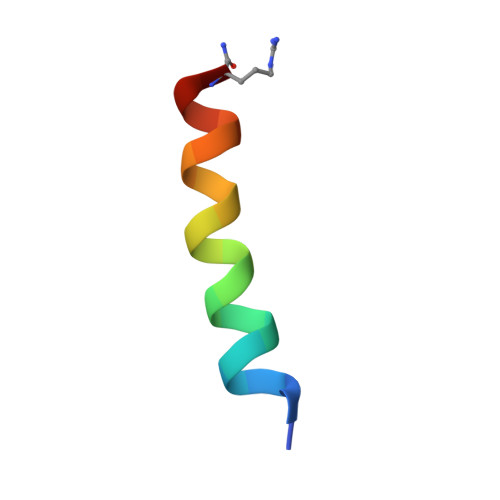NMR conformational analysis of proadrenomedullin N-terminal 20 peptide, a proangiogenic factor involved in tumor growth
Lucyk, S., Taha, H., Yamamoto, H., Miskolzie, M., Kotovych, G.(2006) Biopolymers 81: 295-308
- PubMed: 16315141
- DOI: https://doi.org/10.1002/bip.20418
- Primary Citation of Related Structures:
2FLY - PubMed Abstract:
The preferred conformation of Proadrenomedullin N-Terminal 20 Peptide (PAMP; ARLDVASEFRKKWNKWALSR-amide) has been determined using 1H and 13C two-dimensional nuclear magnetic resonance (NMR) spectroscopy and molecular modeling. PAMP is a peptide that has various physiological functions, including its role as a proangiogenic factor in facilitating tumor growth and its inhibitory effect on catecholamine secretion at nicotinic receptors. The preferred conformation of PAMP was determined in a helix-inducing trifluoroethanol and water (TFE/H2O) solution, and in a membrane-mimetic sodium dodecylsulfate-d25 (SDS) micellar solution. The secondary structure consists of an alpha-helix for residues Arg2 to Arg20 in TFE/H2O solution and an alpha-helix for residues Arg2 to Ala17 in SDS solution. We postulate that the polar charged residues Arg2, Lys12, and Arg20 are responsible for the initial interaction of the peptide with the micelle, and that this is followed by the binding of the hydrophobic residues Leu3, Val5, Phe9, Trp13, and Trp16 to the micellar core. The three C-terminal amino acid residues adopt an extended structure in SDS, suggesting that they are important in receptor recognition and binding. This is supported by truncation studies done by Mahata et al. (Hypertension, 1998, Vol. 32, pp. 907-916), which show the importance of the C-terminal in physiological activity. Furthermore, Belloni et al. (Hypertension, 1999, Vol. 33, pp. 1185-1189), and Martinez et al. (Cancer Research, 2004, Vol. 64, pp. 6489-6494) suggested that the N-terminal was also important in PAMP activity. However, no differences in conformational preference of the N-terminal were observed between the two solvent systems.
Organizational Affiliation:
Department of Chemistry, University of Alberta, Edmonton, Alberta, T6G 2G2, Canada.














